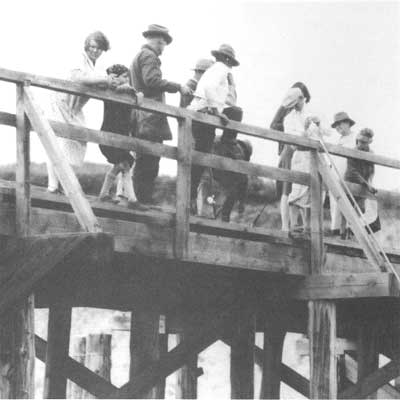 | ||
 | ||
 | ||
 | ||
 | ||
 | ||
 | ||
 | ||
 | ||
 | ||
 | ||
 | ||
 | ||
 | ||
 | ||
 | ||
 | ||
 |
 |
 |
Yellowstone Roads and Bridges
A Glimpse of the Past

Visitors fishing off the old fishing bridge, 1928. Photograph taken by Sam Woodring. |
. . . Before long the rain began to fall, and as the roads were soft clay they soon became very slippery and we had to put on our chains to avoid a serious accident. Even then it was difficult driving on those steep, narrow, winding roads, and we made very poor time, the car just crawling along on low or second gear for hours at a stretch. In places we had to stop and wait for a passing car or truck to extricate itself from the mud, and considered ourselves fortunate that we were not ditched ourselves.
--Mary Crehore Bedell
Modern Gypsies, 1924
On August 1, 1915, automobiles were officially permitted to enter the Park. The admission of automobiles prompted the issuance of new road regulations, primarily that all traffic was one way. Scheduling of travel on the routes was also necessary. The transition from horse-drawn vehicles to the automobile did produce some positive effects on the Park environment. As the roads were paved, the many unsightly water storage tanks for reducing dust on the roads were removed, the vegetation was no longer coated with dust, and it was not necessary to provide feed and board for over 1,300 horses.
Implementation and maintenance of roads in Yellowstone was transferred to the newly-formed National Park Service in 1918. Almost immediately, the Secretary of the Interior, Franklin Lane, reaffirmed the Army Corps of Engineers' philosophy toward road construction in the Park, In his Statement of National Park Policy, he addressed road construction specifically by calling for the harmonizing of roads, trails, buildings and other improvements with the landscape, and the employment of "trained engineers who either possess the knowledge of landscape architecture or have a proper appreciation of the aesthetic value of park lands."
In 1926, the National Park Service and the Bureau of Public Roads reached an agreement that the Bureau would survey, construct, and improve the road system in the Park. At that time most of the park roads were considered unimproved and some of the roads were so narrow that they were restricted to one-way traffic. Because many of the State-Federal highway routes were now of such a high standard, the public appreciated the comfort of traveling on good roads. The park visitor was quick to complain after paying an entrance fee and then having to experience the narrow and dusty roads.

A car stuck in the rutted Cooke City road, 1922 Photograph taken by Linckey. |
We started out from the park this morning. I never seen such grades in all my life. Steep as a barn roof. Burned out my foot-brake right off and then by gosh, we wore out the emergency brake, too. Had to pull over to the road-side and put in new brake shoes. We was lucky to have 'em along, else we'd be stranded up there yet.
--Refers to Sylvan Pass in 1926.
Frederic F. Vande Water
The Family Flivver to Frisco, 1927.
The same difficulties that confronted the Army Corps of Engineers faced the Bureau of Public Roads engineers -- weather, geologic and thermal features, a short construction season, and the transportation of heavy construction equipment. The Bureau initiated the Park survey in 1926 and construction began the following year. The original layout of the Grand Loop and entrance roads proved to meet the needs of the public and it was preferable to reconstruct the existing roads than to pursue additional excavation. The Bureau collaborated with the National Park Service on the design and development of the multi-year project. The Park had a resident landscape architect who inspected road construction and supervised the development of landscape features.
By 1936, 200 miles of the park roads had been improved, 19 major bridges had been constructed, and Chittenden's Golden Gate Viaduct had been reconstructed. The previous Army road standard of an 18 foot width had been increased to 28 feet for the Grand Loop and 26 feet for the entrance roads.
Landscape architects worked hard to minimize impact to the environment. The standard procedure in the park of rounding the tops of cut slopes and flattening of cut and fill slopes became common practice by the highway departments in the surrounding states. If a road was abandoned, great care was taken to reverse the construction operation and reestablish the original contour of the land. Trees were planted, and slopes were covered with topsoil to encourage plant growth.
Road construction was interrupted by World War II, but after 1945, the pre-war plans were implemented. Yellowstone did not experience another major road project until the Mission 66 program, a ten year nationwide National Park Service plan for improvements to facilities to meet the needs of an expected 80 million visitors to all national parks. It was acknowledged in 1956 that Yellowstone's road system was sufficient for visitor usage, thus no new roads were developed. However, modernization included the construction of pullouts and parking strips, and relocation of some roads to minimize the intrusion on natural areas. In addition to road surfacing and some widening of the roads in the Madison, Norris, and Lake Yellowstone areas, bypasses were completed at Lake, West Thumb, and Old Faithful.
In 1988, the Federal Highways Administration began a 20 year reconstruction program in Yellowstone.
| Introduction | Acadia | Blue Ridge Parkway | Chickamauga and Chattanooga | Colonial Parkway | Generals Highway | George Washington Memorial Parkway | Great Smoky Mountains | Mount Rainier | Rock Creek and Potomac Parkway | Shenandoah's Skyline Drive | Southwest Circle Tour | Vicksburg | Yellowstone | Yosemite |
